
My Actual Case: Confidential Outcome
Case type: Personal Injury, Trip and fall on curb in Courtyard of Apartment Complex
Injury: Intertrochanteric hip fracture with rod and screw placed in leg; navicular (wrist) fracture
State/County of Lawsuit/City of Fall: Florida/Miami-Dade/Miami Beach
Claimant’s Attorney: Justin Ziegler
Insurance Company for Apartment Complex/Litigation Claims Adjuster: Insurance Company
Limits of Apartment Complex’s Personal Injury Insurance Coverage: $1,000,000
Limits of “Medical Payments Coverage” in Apartment Complex’s Insurance Policy: $5,000
Date of Accident: 4/28/13
Age, Sex, Occupation of Client: 55, Female, Unemployed (on Disability Prior to Incident)
Cause of Injury: On April 28, 2013 at approximately 5:20 a.m., my client, Kim, was hanging out with a girlfriend, Ivonne, at Kim’s apartment in Miami Beach, Florida. Kim was invited to a party at her friend Julia’s apartment which was located at a different apartment complex.
Kim ordered a taxi to take her and Ivonne to Julia’s apartment. When Kim arrived at Julia’s apartment complex, she and Ivonne exited the taxi. Kim said that Julia greeted Kim and Ivonne at an entrance gate and the 3 of them proceeded to enter the gate.
Kim claimed that she tripped over a curb – that she couldn’t see – in the courtyard of the apartment complex. Kim claimed that she broke the fall with her wrist and landed on her hip. When Kim first contacted me, she already had surgery to repair her fractured femur.
I previously settled Kim’s son’s motorcycle accident case for $445,000 where he had a lower leg fracture. Kim spoke with her son who gave her our contact information. About 2 months after Kim’s trip and fall, she contacted my law firm. All settlements in this article are before deduction for attorney’s fees and expenses. Most cases result in a lower recovery. It should not be assumed that your case will have as beneficial a result.
Kim hires our law firm
Within days after our first phone call, and once Kim was ready to meet with me in person, I met her at her Miami Beach apartment and she hired us. She wanted to make a claim for compensation from the apartment complex.
Personal Injury Claim Against Owner of Apartment Complex’s Insurance Policy
Since Kim was on Medicare and Medicaid at the time of the incident, she had no out of pocket expenses. In order for Kim to have a chance at getting any money under the liability coverage in the apartment complex owner’s insurance policy, under Florida law I would need to be able to show that the apartment complex’s negligence caused Kim’s injuries.
In a Florida trip and fall case you must show that the negligence of the owner or operator of the apartment complex caused your injuries. If you can show this, then you may be entitled to recover her past medical bills, future medical bills and pain and suffering.
Although Medicare and Medicaid paid all of Kim’s medical bills, which amount to somewhere around $55,000, we still made a claim for this $55,000. If you settle a personal injury case, Medicare is entitled to recoup some of the money that they paid to your medical providers for bills relating to the incident.
Tip: There are advantages to hiring a personal injury attorney if you have Medicare and someone’s negligence caused your injuries in a slip, trip or fall (or other type of accident) and you want to make a personal injury claim.
If Medicaid paid bills relating to your injuries sustained in an accident and you recover a settlement, then you have to repay Medicaid a certain amount from the settlement.
Kim also had a claim for pain and suffering damages if I could show that the apartment complex owner’s negligence caused her pain and suffering.
Medical Payments (MedPay) Coverage
Separate and apartment from the liability coverage in the apartment complex’s insurance coverage was $5,000 in medical payments coverage (known as Medpay). Medpay pays your medical providers if you can show that you were injured when you were lawfully on the property. If you have Medicare and/or Medicare, medpay should send a check to Medicare and/or Medicare to pay off some of the bills that they paid relating to your accident.
Effect of Kim’s Boots
Since the footwear that someone was wearing when they tripped and fell is always important to a trip and fall case, I immediately took pictures of the boots (see in the picture below) that Kim was wearing at the time of her fall.
Tip: As you can see, I took multiple pictures of her boots. One picture is not good enough. You should also take pictures of the soles of the boots.
I told Kim to put her the boots in a plastic bag and then in a cardboard container and not wear them again until the conclusion of your claim.
Tip: When determining how much a slip, trip or fall case may be worth, you may need to discount the full value of the case if the claimant was wearing high heels when they fell. This is because the value of a slip or trip and fall case may be reduced by the injured person’s comparative negligence, and the claims adjuster may believe that the high heels may have been a cause of the fall.
I also took a picture of her and the bottle prescription medication (pain killers) that she was taking as a result of the fall.
Tip: You should save all of your prescription bottles and take a picture of them together. It can help illustrate your pain and suffering and may lead to an increased offer from the liability insurer.
If you want to make a claim for injury from a trip and fall, then you should immediately complete a personal injury questionnaire specifically designed for a trip and fall case. I use a personal injury questionnaire in addition to a specific questionnaire for slip or trip and fall cases. While these questionnaires are long, the best time to answer the questions is immediately following the trip and fall accident.
Your memory will fade as time goes on. Documenting all of the facts surrounding the incident may prevent your case from decreasing in value. You should also keep a daily/weekly journal where you talk about the negative effect (e.g. pain, suffering, loss of enjoyment of life, mental anguish, etc.) of your injuries on your life.
I immediately went to the Trip and Fall Scene and Took Pictures.
After speaking with Kim about her incident in person and her hiring me, I immediately drove to the accident scene. As soon as I saw the pink curb, I thought the curb was dangerous because it is painted the same color (pink) as the surrounding flooring. It could be expected that guests would enter the apartment complex through this gate.
I got opinions from other construction professionals as to whether the curb is dangerous
So that I could confirm my suspicions that the pink curb was in fact dangerous, I quickly sent pictures of the curb to a construction manager, and an engineer who each work in the construction field.
They both said that the pink curb (as seen in the picture above with the black arrow pointed at it) should not have been painted the same color as the surrounding flooring. In fact, they said that the curb should not have been there and it was a tripping hazard.
Warning! If you fall at a gated apartment complex or other gated private area, do not enter their property again unless you have permission.
Notice that these picture are taken from outside the gate, even though the gate was open. At the time I took this picture, Julia no longer lived at the apartment complex. If Julia lived there, I would have asked her for permission to enter the premises and take pictures.
Tip: Take pictures from all different angles.
I took a pictures from further away to show the front of the entire complex. I took a picture of the area to the west of the building to show the street light.
Inadequate lighting can be a potential cause or defense of a trip and fall case. I argued that the lights were not working or the lighting was insufficient and contributed to Kim’s fall.
I also took a close up photo of the main gate which Kim claimed that she didn’t enter through because the south gate was open. She said that the lock on the main gate was broken. I also zoomed in on the lighting fixture outside of the lobby which Kim claimed was not working at the time of her fall.
We Requested the Fire Rescue/Ambulance Report
The fire rescue/paramedics report stated that Kim said that she tripped and fell on a curb in the driveway. The paramedic records did not mention anything about our client being on drugs or alcohol.
The paramedics took Kim to Mount Sinai. In my case evaluation, the fact that Kim took an ambulance from the incident scene to the hospital helped her case.
We requested and reviewed the hospital records
The hospital records did not mention anything about our client being on drugs or alcohol.
Tip: Drugs, alcohol and medication can affect the settlement value of a slip or trip and fall case.
You should thoroughly search every page of the paramedic and hospital records to confirm that there is no mention of drugs, alcohol or medication that can result in impairment.
Kim was taken by ambulance to Mount Sinai hospital. An x-ray of her hip revealed a mildly displaced comminuted intertrochanteric fracture of the hip with superior migration of the distal fracture fragment).
An orthopedic surgeon inserted two (2) intramedullary (IM) rods into Kim’s upper leg (femur).
About 1 month later, Kim had constant aching in her non-dominant wrist as well as pain when she would move her wrist. Over the counter medication would help alleviate the pain. Her pain was aggravated by lifting, carrying, twisting, pushing, pulling, gripping and squeezing. The orthopedic doctor diagnosed her with a closed fracture of the navicular bone and referred to a hand specialist.
Interesting fact: Fractures of a non-dominant body part (such as a wrist) are generally worth less than a fracture of a dominant body part. This is because a dominant hand fracture has more of a negative impact on your life than a non-dominant hand fracture.
The hand specialist also diagnosed her with a navicular bone fracture and ordered a CT-scan of her wrist. The CT scan did not show a fracture.
We Located the Address of Apartment Complex Owner
We needed to find out the insurance information for the apartment complex. The fastest way to do this was to locate the owner of the apartment complex.
Why didn’t I just mail the letter to the actual apartment complex? A few reasons. Perhaps it would have been unclaimed as the owner of a large apartment complex most likely does not live there. I also wanted the owner to personally receive our letter. This would save us time.
In order to find out the name of the owner of the apartment complex and thus who to mail my letter to, I went to the Property Search on the Miami Dade County Property Appraiser’s website and typed in the address of the apartment complex where Kim fell. The result is below.
We Tried to Settle Case before Lawsuit
Now that we had the apartment complex owner’s name, I needed to know the address where I could mail a letter requesting their insurance information and for them to preserve any surveillance video. We then looked up the corporation’s address by entering the owner of the apartment complex’s name on Corporation Search by Entity Name on Sunbiz.
Once we had the address of the owner of the apartment complex, we sent the owner a letter requesting their insurance information and to preserve the dangerous curb and surveillance video but they failed to respond. About 20 days later, we then sent a 2nd letter requesting their liability insurance information and they again failed to respond.
Strategy Tip: Each attorney has a different strategy in terms of whether to try to settle a case before a lawsuit. Some attorneys like to try to settle every case before a lawsuit. Other attorneys believe that you gain the upper hand by immediately suing in every case. There may be advantages and disadvantage to each strategy.
Often times, if there is no statute of limitations (deadline to sue) issue, we try to settle a slip or trip and fall or other accident case before a lawsuit. Sometimes it is not possible to settle before suing. For example, sometimes an insurance company will deny liability and offer you nothing. But even if the adjuster denies your case he or she may be dead wrong!
For example, we settled a slip and fall case for $300,000 against a Miami supermarket after the adjuster denied liability and did not make an offer. I also settled a trip and fall ankle injury case for $64,900 after both insurance companies denied liability and offered nothing before I sued the property owner and landscaping company.
Spoke with Witness, Ivonne
I called and spoke with Kim’s friend, Ivonne, who was walking into the apartment complex with Kim when the accident happened. After learning what Ivonne remembered about the fall, I typed an affidavit up for her to sign. Some of the main points in her affidavit were:
- Kim was invited to the property.
- Kim used the south gate to enter the courtyard.
- Kim was on the floor next to the curb in pain.
- It was dark in the area where the fall happened.
- The curb was the same color as the surrounding flooring.
I emailed the affidavit to her and she signed it and sent it to back to me. I then sent the affidavit to the insurance company for the apartment complex.
Tip: In a personal injury case, you want to have as much documentation as possible to support your case. A signed (and even better, notarized) affidavit can make or break a case. I settled a slip and fall case at a Miami hotel for $18,000 where the adjuster offered me nothing prior to giving him a witness affidavit. In certain cases, particularly slip and falls, a witness affidavit may keep the judge from dismissing your case.
Properly drafting a witness affidavit takes time and skill. Because once the insurance company gets the affidavit, it cannot be changed.
We Sued the Apartment Complex Owner
Since the apartment complex did not give us their liability insurance information, we had no choice but to sue them. With Kim’s permission we filed a lawsuit. After we sued them, we received a call from an adjuster from the liability Insurance Company. He wanted the basic facts about the accident and told me that he had assigned the case to defense counsel.
We requested copies of the all of the X-rays and CT scans of Kim’s hip from the hospital
Tip: In most cases, you should request all the actual diagnostic studies (X-rays, CT scans, MRI, etc.) if you have an objective injury (e.g. fracture, fracture with hardware, rods, screws or pins) as this may increase the settlement value of the case.
We requested the diagnostic studies, received them and immediately sent them to the defense attorney. An x-ray taken after surgery is below.

I hired an expert engineer to examine the curb
For a $1,200 initial retainer (fee), I hired engineer Ron Zollo to determine whether the pink curb meets the reasonable standard of care for an apartment complex. I looked up the sun or moon rise/set for Miami Beach on the US Navy website for the date of incident so that I knew the time of sunrise on the day of the incident. As you can see from the chart below, Sunrise on the day of the incident was at 5:48 a.m.

Sunrise on the date of the incident was 1 earlier later than on the day (November 2013) when I met my expert engineer to inspect the premises. Therefore, even though Kim’s accident occurred at 5:45 a.m., the proper time to have met our expert and a defense attorney at the incident scene would have been at 6:45 a.m., because this was sunrise on the date of our inspection November 2013).
The Climate Online Data Search at the National Climatic Data Center for the date of Kim’s fall showed that it was not raining on the day of the fall.
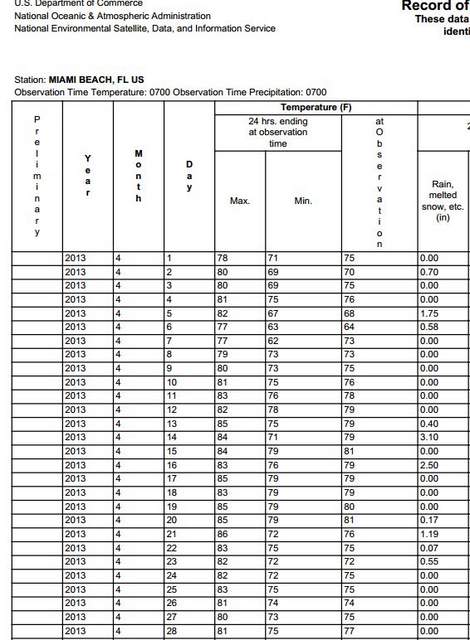
Below is a picture taken by our expert engineer, who met me at the incident scene under similar conditions that existed on the date of the incident.
You can see pictures below taken by my expert under what we argued were similar conditions as the date of the incident. The curb was difficult to see at night. The shadows of the gate make the curb difficult, if not impossible, to see.
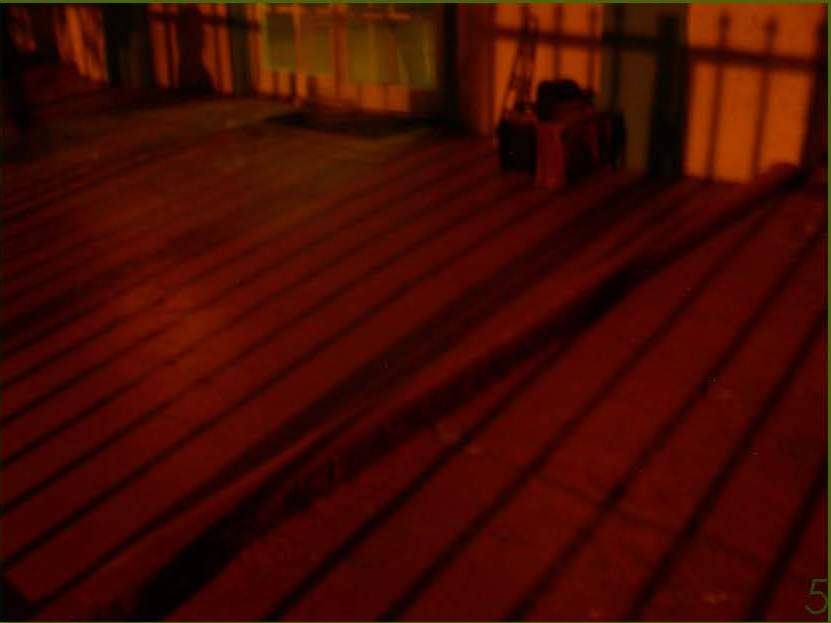
The curb was easier to see with the camera’s flash on but the pink color blends in with the surrounding pink floor.
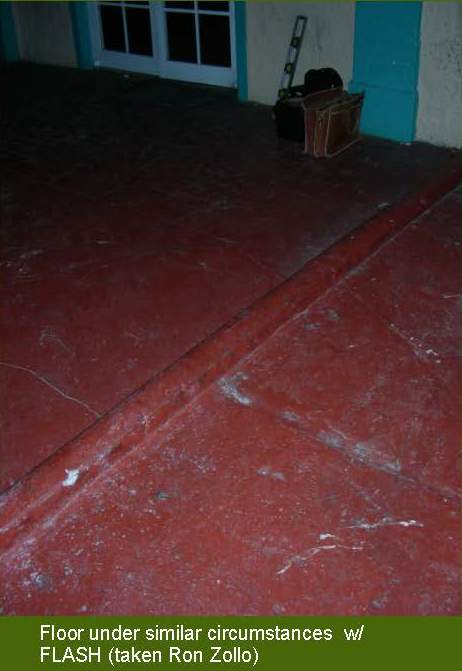
We measured the height of the curb. It was about 3 inches tall.
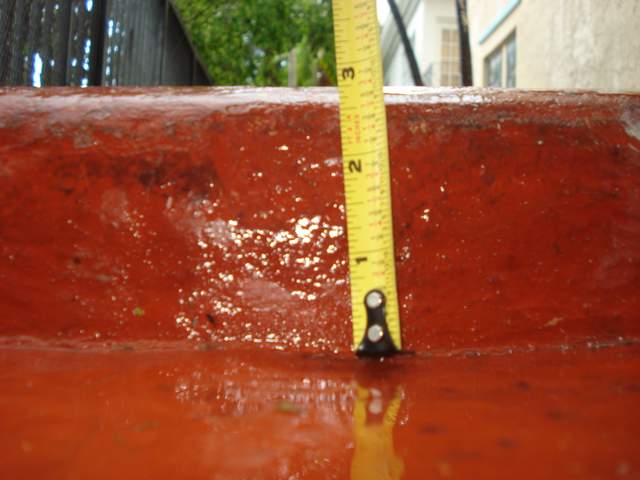
Fun fact: A trip and fall case is often easier to prove if the curb or change in elevation is about 1/2 inch or slightly larger. As the change in elevation increases above 1/2 inch, the curb becomes more obvious to any people walking towards it.
One of the apartment complex’s defenses in this case was that the curb was open and obvious and Kim should have seen it. Therefore, as a general rule you should reduce the settlement value of a trip and fall case (for settlement purposes) by any significant increase in height above 1/2 inch.
So, generally speaking, you have a stronger trip and fall case if you trip on a curb or elevation change that is 1/2 inch as rather than a 2 inches tall. However, there are exceptions to this rule which I won’t discuss here.
Changes in Elevation are Major Contributors to Falls
I argued to the defense attorney that it is common knowledge in the building industry that unmarked changes in levels are major contributors to falls. (Slip, Trip and Fall Prevention: A Practical Handbook, Second Edition). Anyone handling a slip or trip and fall case should read that book.
Expectation of Kim
I also argued that if Kim was aware of the pink curb, she would have tried to avoid it or adjusted her gait (way she walks) to compensate for the differing surface. I argued that Kim would have slowed down when approaching the curb. Slight walking adjustments could have likely allowed her to safely cross the hazardous area.
I argued that Kim was not aware of the pink curb because it matched the surrounding flooring. Thus she could not avoid nor compensate gait for hazard.
In the building safety industry it is common knowledge that guests can cross a dangerous area if they are alert to a dangerous condition. The best option for preventing falls is to get rid of the unexpected condition, in this case the curb, that constitutes the trip and fall hazard.
I spoke with a senior construction manager who said that the cost to remove the curb would have been about $1,500.
We edited the photo of the pink curb to show the defense attorney what the area would have looked like without the curb.
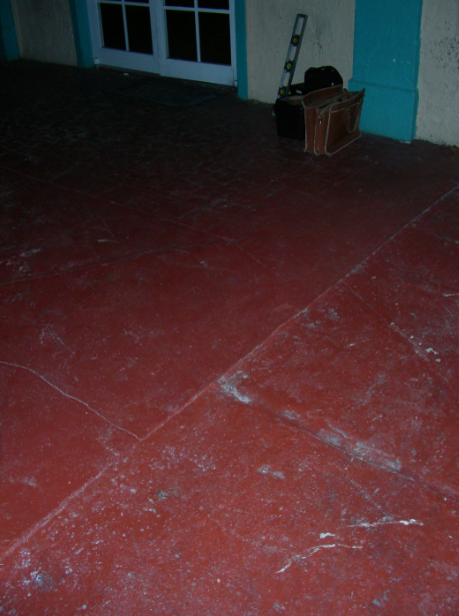
The less desirable method to prevent falls is to assure that guests, such as Kim, receive clear notice of the pink curb (e.g. add yellow paint) so she could have been prepared to deal with it.
The building owner could have simply added bright yellow paint to increase visibility.
I added yellow paint to the curb and added a fall warning sign to the wall on the picture of the curb to show the defense attorney the less desirable option to have prevented this fall.
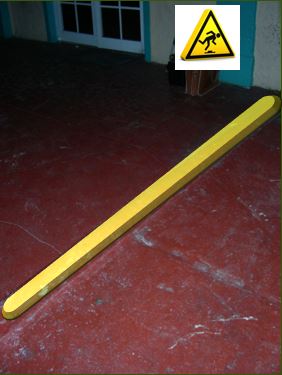
Kim’s fall could have been avoided with 1 can of yellow paint.

When I took the deposition of the apartment complex maintenance man, he stated that it would have taken him less than 30 minutes to paint the curb yellow. A can of paint only costs $5.00 or so and a warning sign costs about $12.
Spoke with Witness, Julia
After several attempts to contact the resident, Julia, who invited Kim to the party, we finally were able to speak with Julia. I drove to Julia’s Miami Beach apartment and spent thirty minutes or so discussing what she remembered from the date of the accident.
I then prepared an affidavit and sent it to her. The affidavit focused on similar facts as the affidavit signed by Ivonne. But two separate affidavits are better than one. We had a notary drive to her apartment to have it notarized. We sent the signed affidavit to the defense attorney.
Kim’s Life Changed Due to her Injuries from Accident
As a result of Kim’s hip fracture from the fall, Kim:
- Needed help from others
- Had difficulty using the bathroom
- Needed assistance with making her meals
- Had Difficulty dressing herself
- Kim had hip pain and limited range of motion for 10 months following the fall.
Kim was wheelchair bound for almost 2 months and was unable to leave home unassisted.
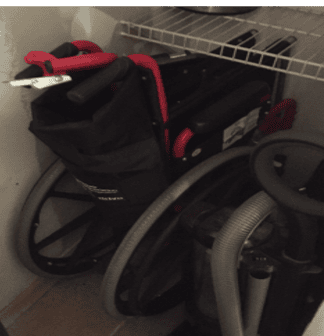
Tip: If you use a wheelchair as a result of your injury from a trip and fall or other accident, take pictures of the wheelchair and immediately send them to the adjuster.

Tip: If you use a stool while showering due to your accident related injuries, take a picture of the stool and send it to the liability claims adjuster immediately.
Kim also used a walker for months after her fall.
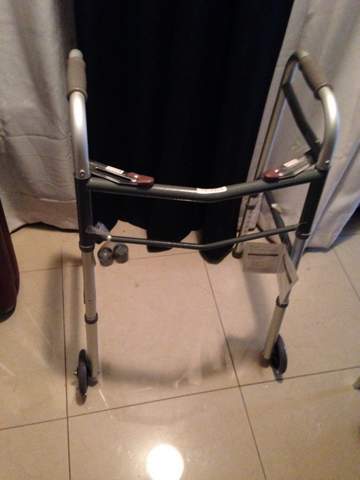
Kim then progressed to using a cane.
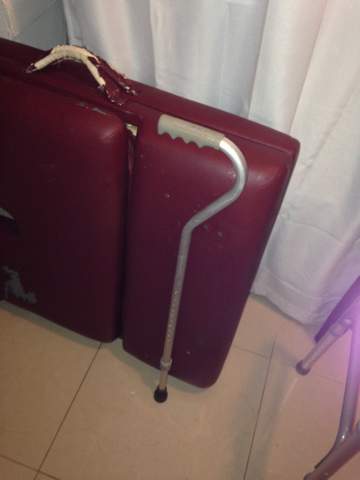
Kim now walks without a cane.
Scarring
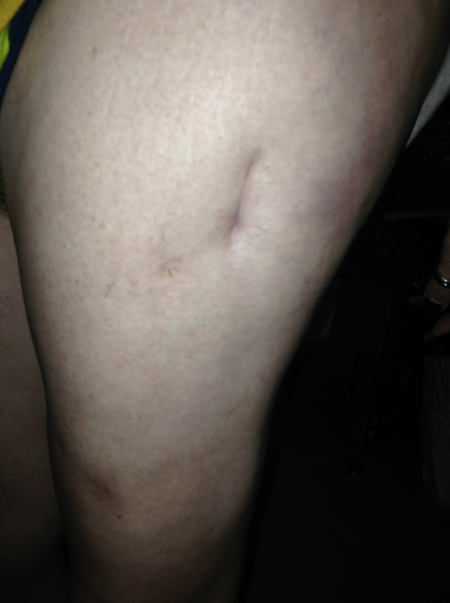
We made a claim for her scarring as a result of the hip surgery.
Tip: If you have surgery, always immediately take pictures of any cuts or scars that you have a result of a fall. Be sure to continue to take pictures as the cut heals and turns into a scar.
Defense attorney takes Kim’s Deposition
Kim testified that she was the last one in the line when they were walking after they had entered the gate.
Tip: The order that you are walking in line may significantly affect the value of a slip or trip and fall case. If someone was first in line before they fell, it is possible to get more money than if others had walked over the dangerous condition immediately before you fell.
I met the Orthopedic Surgeon at his office
I requested an in person meeting with Dr. Wittels, the orthopedic surgeon, who inserted 2 rods into Kim’s upper leg bone (femur) at the hospital. We paid his fee of $750 and met with him. His opinion was that Kim had a great recovery and her hip looks great. He did say that he thought that she had a bad wrist fracture.
Defense Attorney Argues My Expert’s Pictures Hurt Our Case
One of the defense attorney argued to me that our expert’s pictures are blurry and do not fairly and accurately depict the incident scene on the morning of the fall. The defense lawyer argued that even if you take a picture without a flash, it would be much brighter than my expert’s pictures which were taken without a flash. Their attorney argued that the expert’s photos were so dark that it hurt our expert’s credibility.
Arguments Made by the Attorneys for the Apartment Complex
Before mediation, the defense attorneys for the apartment complex made some of the following arguments:
- Kim had pre-existing injuries which affected her gait (walk).
- A jury may conclude that my client was tired, drunk, or on drugs as she was going to a party at 5:45 a.m. in Miami Beach when she fell.
- The area where she fell was perfectly lit.
- Kim should have used the main gate which was not broken. When I took the deposition of the apartment complex maintenance man, he said that the gate which Kim used was locked when Kim fell. Therefore, he argued Kim could have not entered through the gate which she claimed she entered through.
- There were no prior falls over the curb.
- The curb was not dangerous and was open and obvious.
- Kim should have been paying more attention and was wholly or partially at fault.
- The trip couldn’t have occurred as Kim said it did.
Outcome
Confidential Settlement.
Did someone’s carelessness cause your injury in an accident in Florida, or on a cruise or boat?
See Our Settlements
Check out some of the many Florida injury cases that we have settled, including but not limited to car accidents, truck accidents, slip or trip and falls, motorcycle accidents, drunk driving (DUI) accidents, pedestrian accidents, drunk driving accidents, taxi accidents, accidents involving a Uber or Lyft Driver, bicycle accidents, cruise ship accidents, and much more.
We want to represent you!
Our Miami law firm represents people injured anywhere in Florida in car accidents, truck accidents, slip, trip and falls, motorcycle accidents, bike accidents, drunk driving crashes, pedestrian accidents, cruise ship or boat accidents and many other types of accidents.
We want to represent you if you were injured in an accident in Florida, on a cruise ship or boat. If you live in Florida but were injured in another state we may also be able to represent you.
Call Us Now!
Call us now at (888) 594-3577 to find out for FREE if we can represent you.
No Fees or Costs if We Do Not Get You Money
There are No Fees or Costs Unless We Recover Money. Call us 24 hours a day, 7 days a week, 365 days a year. We speak Spanish. We invite you to learn more about us.
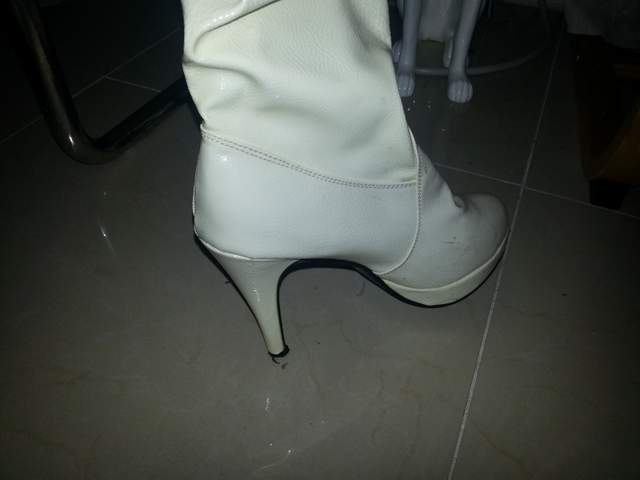
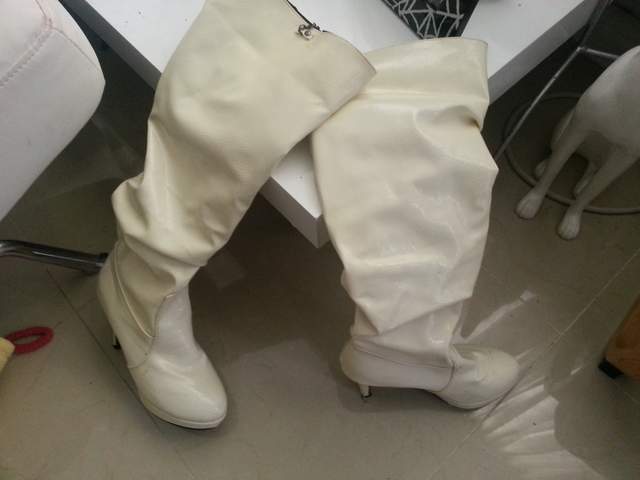
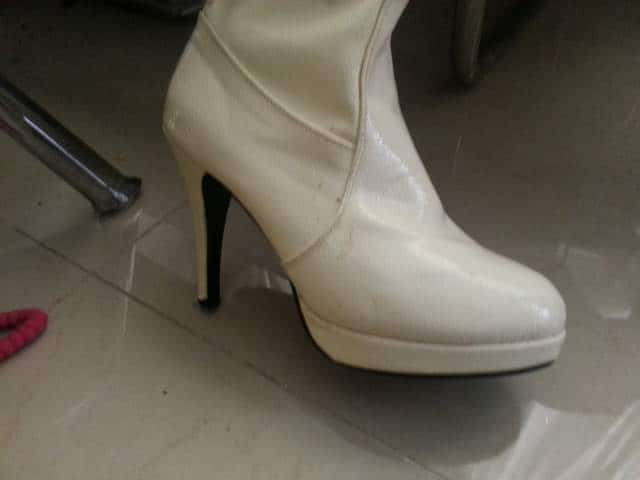
Leave a Reply